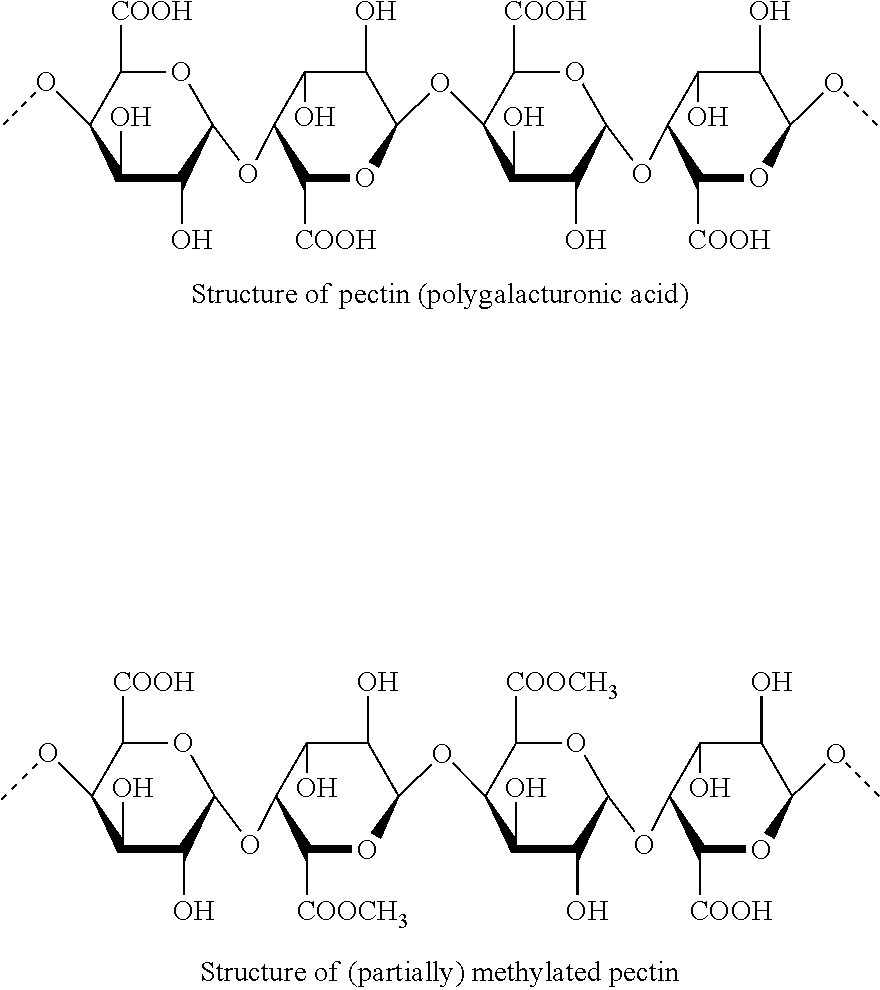Feed compositions for preventing and treating inflammatory diseases
- Summary
- Abstract
- Description
- Claims
- Application Information
AI Technical Summary
Benefits of technology
Problems solved by technology
Method used
Image
Examples
example 1
Pectin Inhibition of TLR2-Mediated NFkB Activation
[0077]Cell Lines and Cultivation
[0078]Cell lines were cultured in DMEM culture media (Lonza, Basel, Switzerland) with 10% decomplemented Fetal Calf serum, 50 U / ml Penicillin (Sigma, St. Louis, Mo., USA), 50 μg / ml Streptomycin (Sigma, St. Louis, Mo., USA) and 100 μg / ml Normocin (InvivoGen, Toulouse, France).
[0079]HEK-Blue™ TLR2-CD14 cells (InvivoGen, Toulouse, France) expressing human TLR2 and SEAP (Soluble Embryonic Alkaline Phosphatase) were used. NFκB and AP1 are stimulated to move to the nucleus in these cell lines when TLR2 is activated by an agonist. Here, the SEAP gene is under the control of a NFκB / AP-1 responsive promoter. Upon expression, the SEAP gene product is secreted in media and can be quantified using the Quantiblue (InvivoGen, Toulouse, France) solution. The enzyme converts the pink color into blue depending on the activity, and this can be measured with a spectrophotometer.
[0080]1×HEK-Blue™ Selection (InvivoGen, Tou...
example 2
Pectin Binds to TLR2
[0089]Construction of the TLR2ectodomain-HA Expression Plasmid
[0090]RNA was extracted from HEK-Blue™ hTLR2-CD14 cells using the RNeasy® Plus Mini kit (Qiagen, Venlo, Netherlands). cDNA was synthesized using OligodT primers (Life technologies, Carlsbad, Calif., USA), dNTP mix (Life technologies, Carlsbad, Calif., USA) and Superscript™ III Reverse Transcriptase (Life technologies, Carlsbad, Calif., USA) according to the suppliers' manuals. TLR2 from codon1 to codon586 was synthesized using cDNA from HEK-Blue™ hTLR2-CD14 using the forward primer 5′-GCGCACCGGTATGCCACATACTTTGTGGATGG-3′, the reverse primer 5′-GCGCGGATCCGTGACATTCCGACACCGAGAG-3′ and Pfu DNA polymerase (Thermo scientific, Waltham, Mass. USA). Primers were flanked by a GC doublet at the 5′ end for restriction enzyme recognition. AgeI and BamHI restriction sites were included in the forward and reverse primer, respectively. The PCR product was digested with AgeI and BamHI restriction enzymes (Thermo scienti...
example 3
Pectin Inhibits Only the Pro-Inflammatory Pathway of TLR2 and not its Regulatory Pathway
[0102]Cell Line
[0103]HEK-Blue™ Null1 (InvivoGen, Toulouse, France) was seeded at 500,000 cells / ml in 12 well culture plates and incubated overnight. The following day, transfection was performed by using Lipofectamine LTX® (Life technologies, Carlsbad, Calif., USA). Plasmid pUNO3-hTLR2 (InvivoGen, Toulouse, France) was linearized with NotI (Thermo scientific, Waltham, Mass. USA). One μg of purified DNA was diluted in low serum media Opti-MEM® (Life technologies, Carlsbad, Calif., USA) and mixed with 3.5 μl of Lipofectamine LTX® (Life technologies, Carlsbad, Calif., USA). This transfection mix was incubated for 30 min at room temperature and then added to the previously seeded cells in the culture media. Cells were incubated with transfection medium mix for 24 hrs and transfected cells were selected using Zeocin (100 μg / ml) and Hygromycin B (150 μg / ml) in DMEM culture media (Lonza, Basel, Switzerl...
PUM
| Property | Measurement | Unit |
|---|---|---|
| Fraction | aaaaa | aaaaa |
| Fraction | aaaaa | aaaaa |
| Fraction | aaaaa | aaaaa |
Abstract
Description
Claims
Application Information
 Login to View More
Login to View More - R&D
- Intellectual Property
- Life Sciences
- Materials
- Tech Scout
- Unparalleled Data Quality
- Higher Quality Content
- 60% Fewer Hallucinations
Browse by: Latest US Patents, China's latest patents, Technical Efficacy Thesaurus, Application Domain, Technology Topic, Popular Technical Reports.
© 2025 PatSnap. All rights reserved.Legal|Privacy policy|Modern Slavery Act Transparency Statement|Sitemap|About US| Contact US: help@patsnap.com

